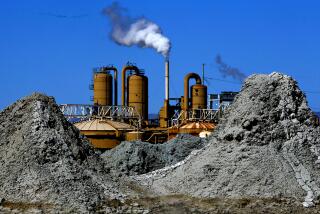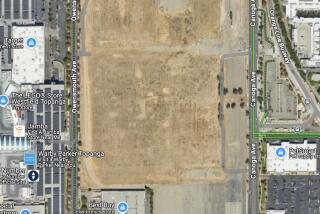New Data Clouds Ward Valley Plan : Environment: U.S. scientists acknowledge year-old evidence of radioactive pollutants in desert. Revelation could affect proposal for nuclear waste dump.
With the federal government closer than ever to handing over land for the proposed Ward Valley nuclear waste dump in the Mojave Desert, U.S. scientists have acknowledged the existence of year-old evidence that the desert may not be the safest place to bury radioactive debris.
The discovery of surprisingly high levels of radioactive pollutants in desert sands near a waste dump in Beatty, Nev., has led scientists to concede they understand less than they thought about how radioactive matter migrates through arid terrain.
The discovery of tritium and carbon-14 near the Beatty dump site could have important implications for Ward Valley, where opponents of the proposed dump fear that long-lived waste particles could leach into the water table and ultimately to the nearby Colorado River, a source of drinking water for millions. At the Beatty site, tritium has been found 357 feet below the surface, about 10 feet above the water table.
On Monday, upon learning of the findings, two members of a National Academy of Sciences panel, created to study the safety of the Ward Valley site, sent a letter to U.S. Interior Secretary Bruce Babbitt urging him to renew a commitment to require additional tests at Beatty and Ward Valley.
At the same time, the release of the findings over a year after they were made by a government scientist has prompted opponents of the Ward Valley project to call for an investigation of whether there was a cover-up of the data.
Initially found in April, 1994, the results were not revealed to the National Academy panel that assembled in July of that year to investigate the suitability of the Ward Valley site. The panel gave a qualified endorsement of the site in May after a nine-month review.
“This appears to be an astonishing cover-up of a matter that could affect the safety of millions of people,” said Daniel Hirsch, a leader of the campaign against the Ward Valley project.
Hirsch said the findings by Interior Department hydrologist David Prudic did not come to light until last week, when he asked Prudic if there were any additional material from research at Beatty that might apply to Ward Valley.
In an interview Monday, Prudic said he was puzzled by the findings and, consequently, slow to reveal them.
“The significance of the Beatty findings is that we don’t understand how the tritium moved as far as it did,” he said. “Something happened that we are not aware of. . . . Some process that we cannot explain caused significant concentrations to migrate well beyond the area of the waste trenches.
“If we can’t understand it at one particular place, it becomes difficult to make predictions about what will happen somewhere else that is similar,” Prudic said, adding that the terrain at Beatty and Ward Valley is similar.
Prudic defended his decision not to reveal his initial findings to the National Academy panel. He testified before the panel in July of last year.
“It was the first time I had done sampling of this kind, and I wanted to be sure of its significance,” he said.
About nine months later, armed with supporting data from additional test results, Prudic said he and his research partner filed the first of several reports detailing their findings to superiors at the Department of the Interior.
According to Prudic, a particularly thorny problem was determining whether the levels of tritium and carbon-14 he was finding in the ground were substantially higher than those that occur naturally in the atmosphere. Around Beatty, so-called background levels of these radioactive isotopes have been unusually high in the past because of atmospheric nuclear testing that occurred in the 1950s and 1960s.
At the Beatty site, which closed a few years ago after 30 years of operation, the challenge is trying to ascertain what might cause residual amounts of tritium and carbon-14. Was it the testing, which ended in the early 1960s, or was it the dump?
The results of Prudic’s subsurface sampling reveal levels of tritium and carbon-14 that are many times higher than what is found normally in the atmosphere, creating a strong suspicion that the dump was the culprit.
“The philosophy of these sites is that you have such large, thick zones of impermeable sediments that they trap any moisture moving through,” said Martin D. Mifflin, a hydrologist, a member of the National Academy panel on Ward Valley and author of the letter to Babbitt. “But if that’s not happening, we are kidding ourselves that we have an environment that acts as a good barrier against the migration of buried waste.”
Mifflin said he is asking Babbitt to require more testing both at Beatty and at Ward Valley before transferring the land, which is owned by the federal government, to the state, which would operate the Ward Valley facility.
Even without the latest information, the National Academy in its final report last spring recommended that additional testing of soil permeability be done at Ward Valley.
As a result of that recommendation, Babbitt sought a legally binding commitment from the Wilson Administration to perform additional testing of the site before any waste was deposited there.
But under pressure from Congress, as well as from California Gov. Pete Wilson, to hand over the land, the Interior Department recently softened its original demand.
Babbitt could not be reached for a comment Monday on the latest developments.
Elisabeth Brandt, chief counsel for the state’s Department of Health Services, said she did not believe that the Beatty findings raised new concerns for the Ward Valley project.
“The Beatty site had considerably different disposal practices,” Brandt said. “That may have included pouring liquid tritium directly onto the ground and allowing the disposal of unpackaged waste. The disposal practices will be entirely different at Ward Valley. We won’t allow liquids or unpackaged waste. So, I don’t think you can learn anything by studying the migration of mobile isotopes at Beatty.”






